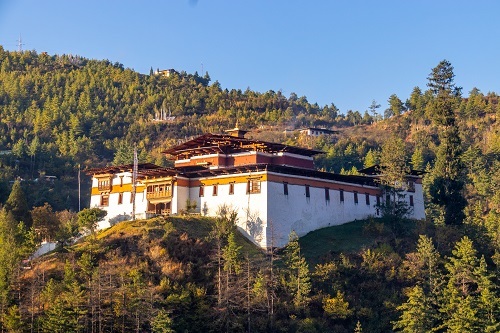Dzongs – Living Monuments of the Zhabdrung’s Legacy
Flying into Paro, the only airport in the country, it is impossible to miss a fortress like structure jutting out from the hillside and overlooking the quiet valley below. That structure is known as the Dzong. For anyone even remotely familiar with our small mountain kingdom, the Tiger’s Nest Monastery is usually what comes to mind. However, upon visiting, one will soon realize the all important status of our Dzongs, as well as the wealth of history behind it.
After the greenery of our forests and valleys, and the white snow on the mountain peaks, it is the Dzongs that dominate the Bhutanese landscape. Wherever one travels these magnificent structures in white situated either on strategic hilltops or the confluence of rivers, stand out as the finest examples of Bhutanese construction and design. They are very beautiful and functional at the same time.
After the greenery of our forests and valleys, and the white snow on the mountain peaks, it is the Dzongs that dominate the Bhutanese landscape. Wherever one travels these magnificent structures in white situated either on strategic hilltops or the confluence of rivers, stand out as the finest examples of Bhutanese construction and design. They are very beautiful and functional at the same time.

Introduced in Bhutan in the 17th century by Zhabdrung Ngawang Namgyel, Dzongs are perfect examples of Bhutanese architecture. A fascinating feature of the Dzongs are that they were built without the aid of blueprints, designs, drawings or nails. It all comes out of a concept matured perfectly over three centuries in the mind of the builder.
Built in 1629, Semtokha Dzong in Thimphu is the oldest Dzong in the country. Over time, with the increase in the Zhabdrung’s political dominion, it was to consolidate his political sway over the people of the western valleys by strengthening his defence position that he embarked on the construction of his first Dzong at Semtokha in Thimphu. During the construction of the Dzong, the design for which was based on a tantric college in Tibet, his students from Tibet and the local areas carried out the building works during the daytime and received teachings from the Zhabdrung in the evenings. Rival lamaist factions did try to hinder the construction process but were defeated in the battle that followed and the construction went on. And thus the first ever Dzong in Bhutan came into existence. In the years that followed, Dzongs were built in every district in the country. And all of them have a common design principle.
Though first timers may mistake the Dzong for a massive house Dzongs can be easily distinguished from ordinary houses by its comparatively larger size and the red band just below the roof that runs around its walls, as well as the golden ‘Sertho’ or cupola on the roof. Contrary to most medieval castles in Europe that are relatively dead monuments and literally empty places, our Dzongs are still very much in use today. A visit to any of our Dzongs is sure to evoke a sense of medieval ambience and makes the monastery-fortress appear no less than a living museum.
The Dzong is a structure designed to serve three functions – as a fortress, a monastery and the administrative cum judicial centre of the region in which it is situated. The first seat of power in Bhutan was located in a Dzong, which explains why they served as fortresses and watchtowers. They were also built to assimilate with the surrounding terrain and provide a strategic advantage for our troops in the event of attacks. There is a Dzong each in every district, with the exception of Thimphu and Paro, which have two Dzongs. The Dzong in Thimphu – the capital city, houses the office of His Majesty the King of Bhutan.
Dzongs are decorated by complex wood carvings and paintings. Inside the Dzong, the religious and civil quarters are divided by an ‘Utse’ or the central tower. The Dzongs have a central edifice with many floors and its roof tied with metal chains, several shrines for deities, jingling bells and decorations of sun and moon shaped icons called ‘mirrors’ and surrounding high walls with parapets and a large entrance. The main courtyard of the Dzong is the ‘Dochey,’ which is paved with large flagstones and it is here that the mask dances are carried out during religious festivals. Overlooking the Dochey are several rooms and galleries which serve as living quarters and classrooms for the monks.
Our people are very very religious and the main motto of our architecture is to contribute to retaining our culture and heritage. The strong architectural character of these massive structures are very vernacular to Bhutan and Bhutan alone, as you will come to find out for yourselves. It is quite different to say the least. Infact ‘beyond amazing’ is the phrase used by most visitors to our Dzongs.
Built in 1629, Semtokha Dzong in Thimphu is the oldest Dzong in the country. Over time, with the increase in the Zhabdrung’s political dominion, it was to consolidate his political sway over the people of the western valleys by strengthening his defence position that he embarked on the construction of his first Dzong at Semtokha in Thimphu. During the construction of the Dzong, the design for which was based on a tantric college in Tibet, his students from Tibet and the local areas carried out the building works during the daytime and received teachings from the Zhabdrung in the evenings. Rival lamaist factions did try to hinder the construction process but were defeated in the battle that followed and the construction went on. And thus the first ever Dzong in Bhutan came into existence. In the years that followed, Dzongs were built in every district in the country. And all of them have a common design principle.
Though first timers may mistake the Dzong for a massive house Dzongs can be easily distinguished from ordinary houses by its comparatively larger size and the red band just below the roof that runs around its walls, as well as the golden ‘Sertho’ or cupola on the roof. Contrary to most medieval castles in Europe that are relatively dead monuments and literally empty places, our Dzongs are still very much in use today. A visit to any of our Dzongs is sure to evoke a sense of medieval ambience and makes the monastery-fortress appear no less than a living museum.
The Dzong is a structure designed to serve three functions – as a fortress, a monastery and the administrative cum judicial centre of the region in which it is situated. The first seat of power in Bhutan was located in a Dzong, which explains why they served as fortresses and watchtowers. They were also built to assimilate with the surrounding terrain and provide a strategic advantage for our troops in the event of attacks. There is a Dzong each in every district, with the exception of Thimphu and Paro, which have two Dzongs. The Dzong in Thimphu – the capital city, houses the office of His Majesty the King of Bhutan.
Dzongs are decorated by complex wood carvings and paintings. Inside the Dzong, the religious and civil quarters are divided by an ‘Utse’ or the central tower. The Dzongs have a central edifice with many floors and its roof tied with metal chains, several shrines for deities, jingling bells and decorations of sun and moon shaped icons called ‘mirrors’ and surrounding high walls with parapets and a large entrance. The main courtyard of the Dzong is the ‘Dochey,’ which is paved with large flagstones and it is here that the mask dances are carried out during religious festivals. Overlooking the Dochey are several rooms and galleries which serve as living quarters and classrooms for the monks.
Our people are very very religious and the main motto of our architecture is to contribute to retaining our culture and heritage. The strong architectural character of these massive structures are very vernacular to Bhutan and Bhutan alone, as you will come to find out for yourselves. It is quite different to say the least. Infact ‘beyond amazing’ is the phrase used by most visitors to our Dzongs.
